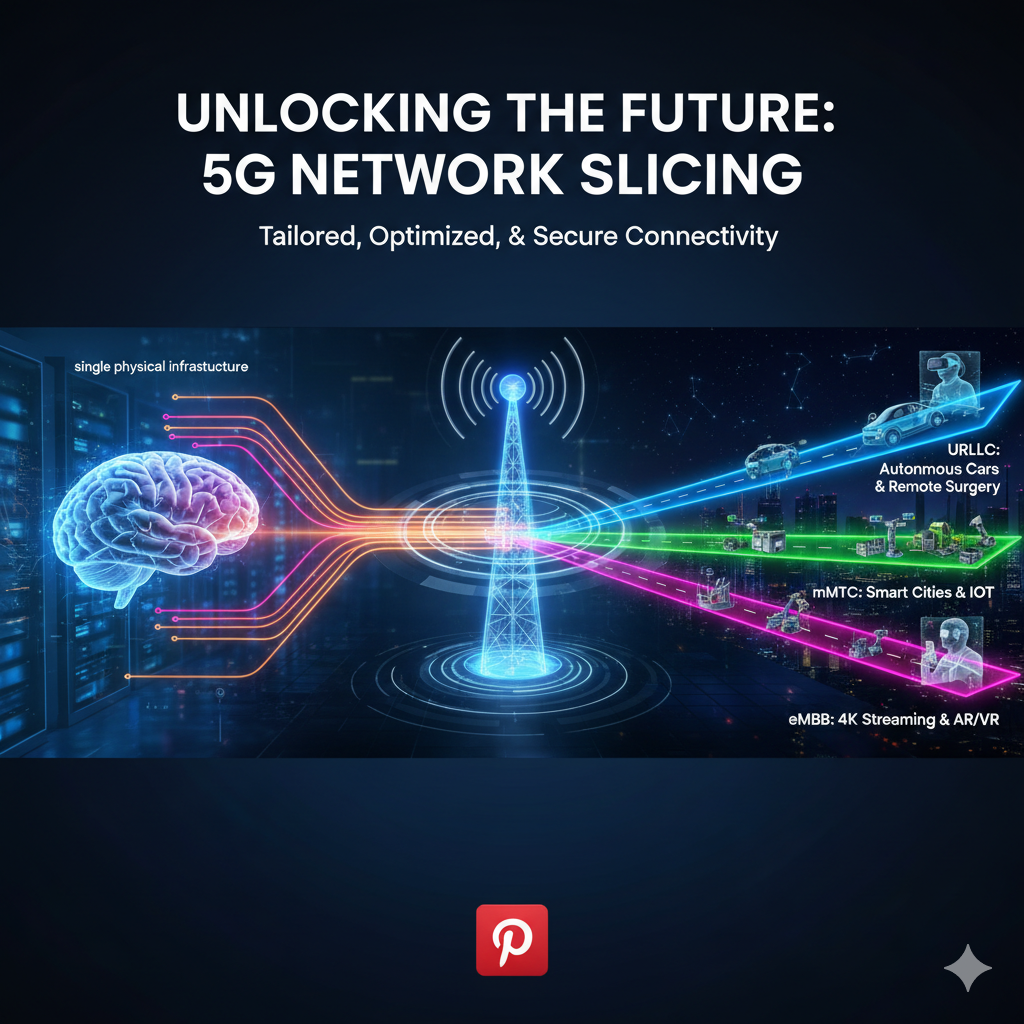
Have you ever imagined a world where your network connection isn’t just fast, but intelligently designed for your exact needs?
A world where a surgeon performing remote surgery has a network slice guaranteeing ultra-low latency,
while a smart factory operates with a slice optimized for massive machine-to-machine communication,
and you, the casual user, enjoy seamless 4K video streaming on a different, dedicated slice?
This isn’t science fiction; it’s the promise of 5G network slicing,
a groundbreaking technology that is fundamentally reshaping how we perceive and utilize mobile networks. It’s about moving beyond a
“one-size-fits-all” approach to a highly customized, service-oriented network paradigm.
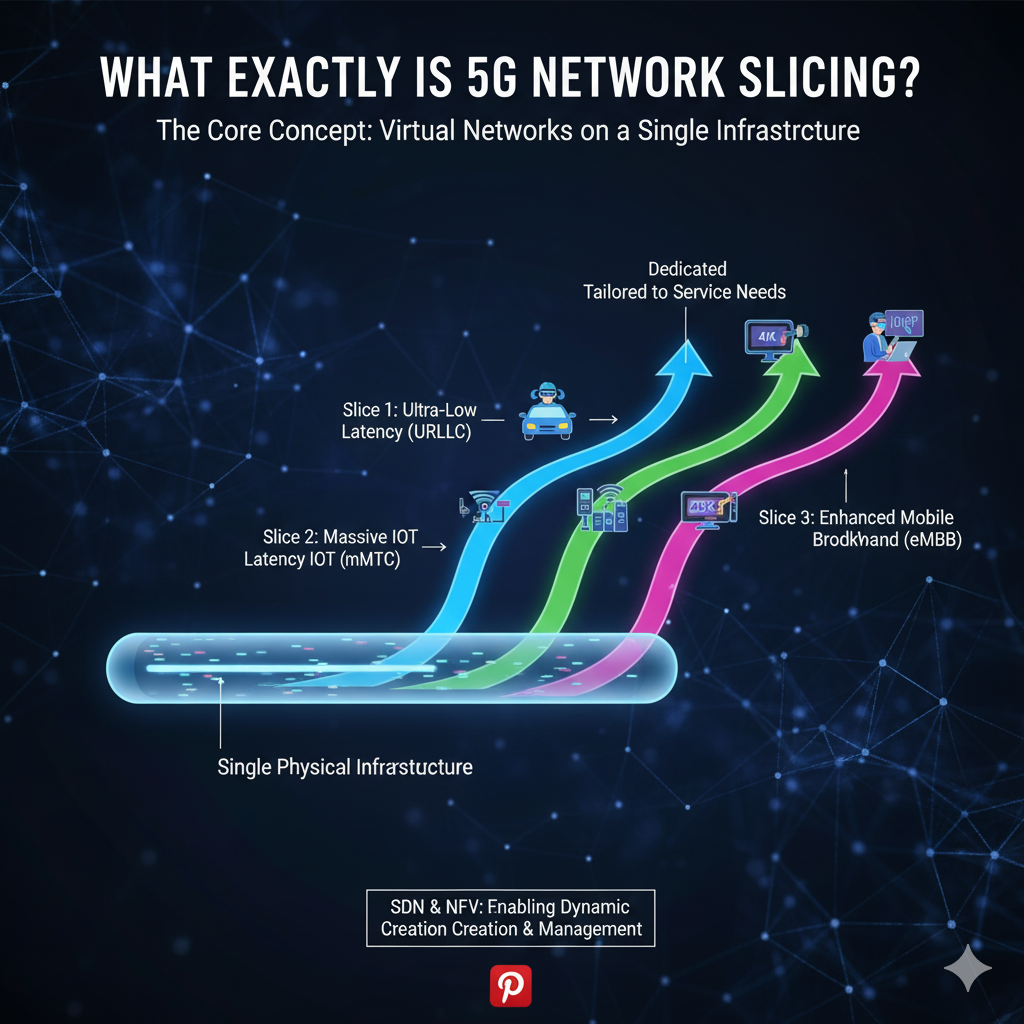
What Exactly is 5G Network Slicing?
At its core, 5G network slicing is a network architecture that allows for the creation of multiple independent, virtualized, and logical networks atop a single, shared physical network infrastructure [1].
Think of it like a physical highway that can be dynamically reconfigured into several distinct, dedicated lanes, each designed for a specific type of vehicle or purpose.
Each of these “lanes,” or network slices, is an isolated, end-to-end network specifically tailored to fulfill the diverse and often contrasting requirements of a particular application or service [3].
This revolutionary capability is crucial for 5G mobile networks, which are designed to support a vast array of services, each with unique demands for bandwidth, latency, reliability, and security.
From massive IoT deployments to ultra-reliable low-latency communications (URLLC) for critical applications, 5G network slicing provides the flexibility needed to efficiently manage these varied service level requirements (SLRs) within a unified infrastructure [1].
The magic behind network slicing lies in its reliance on two pivotal technologies:
Software-Defined Networking (SDN) and Network Function Virtualization (NFV).
SDN allows for the centralized control and programmability of network infrastructure, decoupling the network’s control plane from its data plane.
NFV, on the other hand, virtualizes network functions that traditionally ran on proprietary hardware, enabling them to run as software instances on standard servers.
Together, SDN and NFV facilitate the dynamic creation, deployment, and management of these flexible and scalable network slices over a common physical network [1, 4, 5].
From a business perspective, network slicing opens up new avenues for revenue generation.
Mobile Virtual Network Operators (MVNOs), for instance, can administer their own network slices.
The infrastructure provider, who owns the physical network, can lease resources to MVNOs.
These MVNOs can then autonomously deploy and customize multiple network slices to cater to the specific needs of their users and applications [1, 6, 7, 8].
This fosters a more competitive and innovative ecosystem, allowing for specialized services that were previously unimaginable.
A Glimpse into the Past: The Evolution of Network Slicing
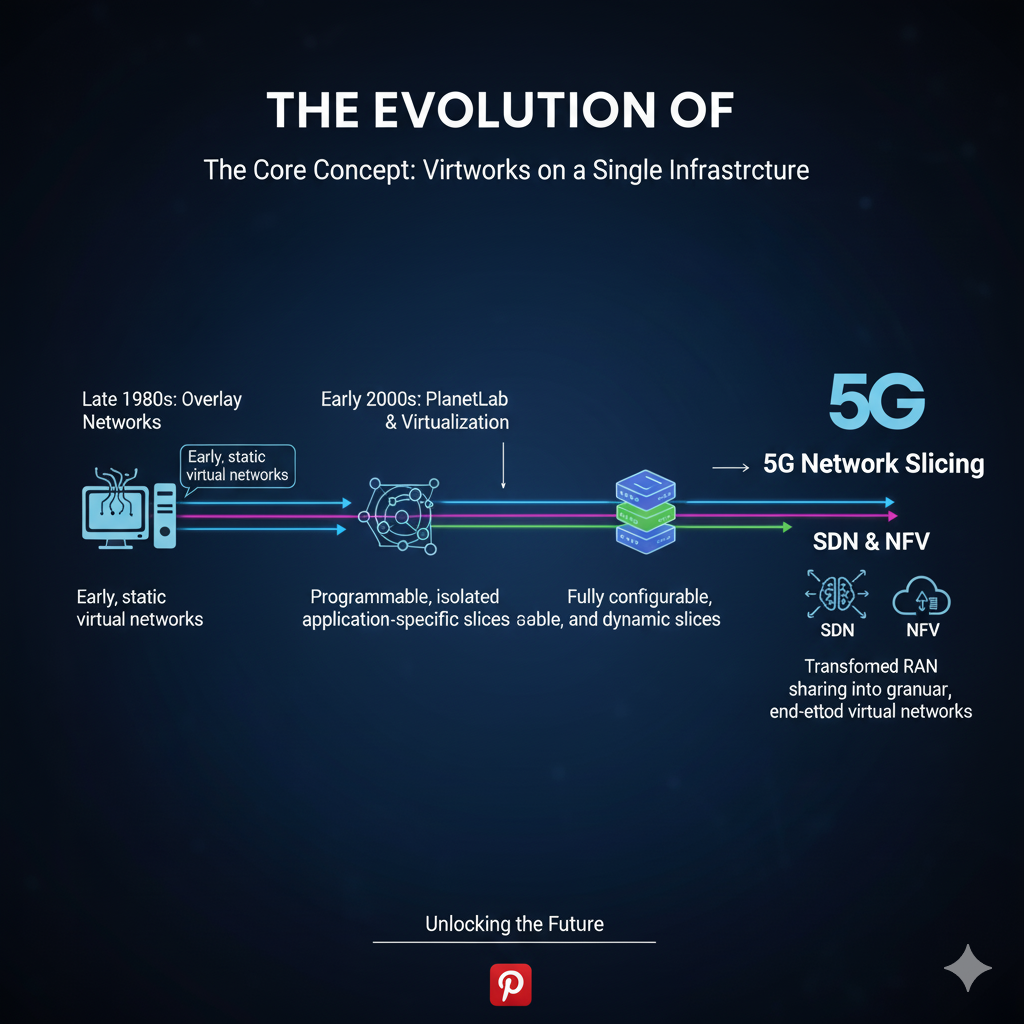
The concept of “slicing” a network isn’t entirely new; its roots can be traced back to the late 1980s.
Early forms of network slicing emerged with overlay networks, which combined heterogeneous network resources to create virtual networks over a common infrastructure [9, 10].
However, these early iterations lacked the programmability and dynamic reconfigurability that modern network slicing offers.
The early 2000s saw significant advancements with projects like PlanetLab, which introduced a virtualization framework.
This allowed groups of users to program network functions, leading to the creation of isolated, application-specific slices.
The true breakthrough arrived in 2009 with the advent of SDN technologies.
SDN provided open interfaces and centralized control, enabling the realization of fully configurable and scalable network slices [9, 10].
In the context of mobile networks, network slicing evolved from the concept of RAN sharing (Radio Access Network sharing), initially introduced in the LTE standard [11].
Technologies like Multi-Operator Radio Access Networks (MORAN) and Multi-Operator Core Networks (MOCN) allowed network operators to share common LTE resources within the same RAN.
While these were precursors, 5G network slicing takes this concept to an entirely new level, offering far greater granularity, isolation, and dynamic management capabilities.
Key Concepts: The Building Blocks of Slicing
The traditional “one-size-fits-all” network paradigm of past mobile networks (2G, 3G, and 4G) is no longer sufficient for the diverse demands of today’s digital landscape [1, 3, 12].
5G network slicing addresses this by enabling a single physical network infrastructure to accommodate vastly different Quality of Service (QoS) requirements [1, 13].
To achieve this, several key techniques are employed:
Network Functions: These are the elementary functionalities that act as the building blocks for every network slice.
They define the specific behaviors and interfaces required for a particular service.
Virtualization: This provides an abstract representation of physical resources, allowing for a unified and homogeneous scheme.
Through NFV, network functions are decoupled from hardware, enabling scalable and flexible slice deployment.
Orchestration: This crucial process coordinates all network components involved in the lifecycle of each network slice.
SDN plays a vital role here, facilitating dynamic and flexible slice configuration.
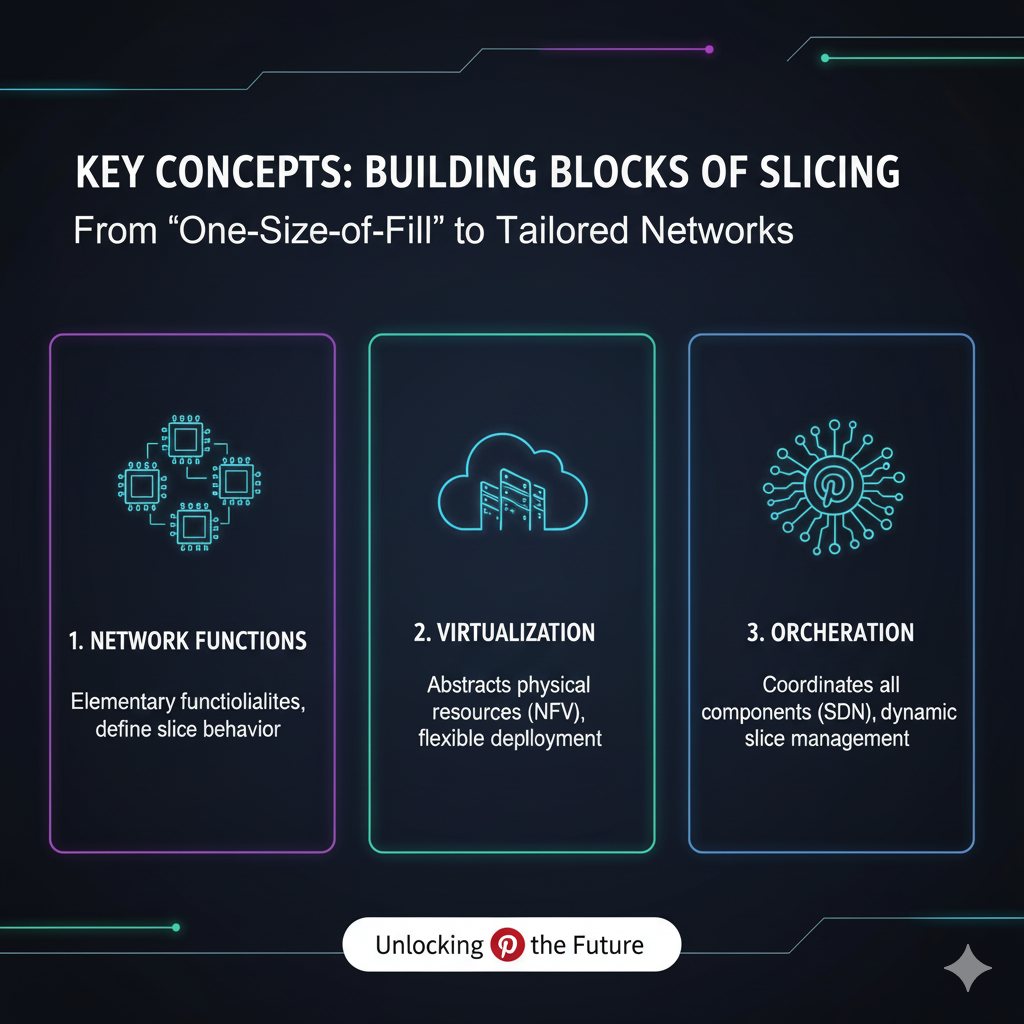
Architecture Overview: How Slices are Built
While various network slice architectures exist, a general framework can be identified.
This framework typically consists of two main blocks: one for the actual slice implementation and another for slice management and configuration [3].
The slice implementation block is often a multi-tier architecture comprising three layers:
Service Layer: This layer directly interfaces with business entities like MVNOs and third-party service providers.
It translates service requirements into formal _service instances_, which encapsulate the necessary network characteristics and SLA requirements for a suitable slice creation [20].
Network Function Layer: Responsible for creating network slices based on requests from the service layer.
It utilizes a set of _network functions_ that are placed over the virtual network infrastructure and chained together to form an end-to-end network slice instance.
This instance reflects the specific network characteristics demanded by the service [1, 4].
Infrastructure Layer: This is the underlying physical network infrastructure that provides the computing, storage, and networking resources upon which the virtualized network functions and slices operate.
Coordinating these layers is the network slice controller.
This centralized entity monitors and manages the functionalities across all three layers, ensuring the efficient coexistence and operation of multiple slices [9].
The Impact and Applications of Network Slicing
Network slicing offers mobile operators the unprecedented ability to create specialized virtual networks tailored to specific clients and use cases.
Imagine the possibilities across various industries [14, 15]:
Enhanced Mobile Broadband (eMBB): Dedicated slices can provide guaranteed high bandwidth and low latency for premium video streaming, cloud gaming, and augmented/virtual reality (AR/VR) applications, ensuring a superior user experience.
Massive Machine-Type Communications (mMTC): For IoT deployments in smart cities, agriculture, or manufacturing, slices can be optimized for connecting a vast number of devices with low power consumption and infrequent data transmission, such as smart sensors and utility meters.
Ultra-Reliable Low-Latency Communications (URLLC): Critical applications like autonomous vehicles, remote surgery, industrial automation, and public safety communications demand extremely low latency and high reliability.
Dedicated URLLC slices can guarantee these stringent performance requirements, potentially saving lives and preventing industrial accidents.
Furthermore, network slicing can significantly benefit MVNOs,
allowing them to support diverse use cases with tailored parameters—for example, low latency and high speed for video streaming for OTT-focused MVNOs, or lower speed for telemetry operations.
It also enhances service continuity through improved roaming, creating virtual networks that span multiple physical infrastructures [15].
Challenges on the Horizon
While the promise of 5G network slicing is immense, its implementation comes with its own set of challenges:
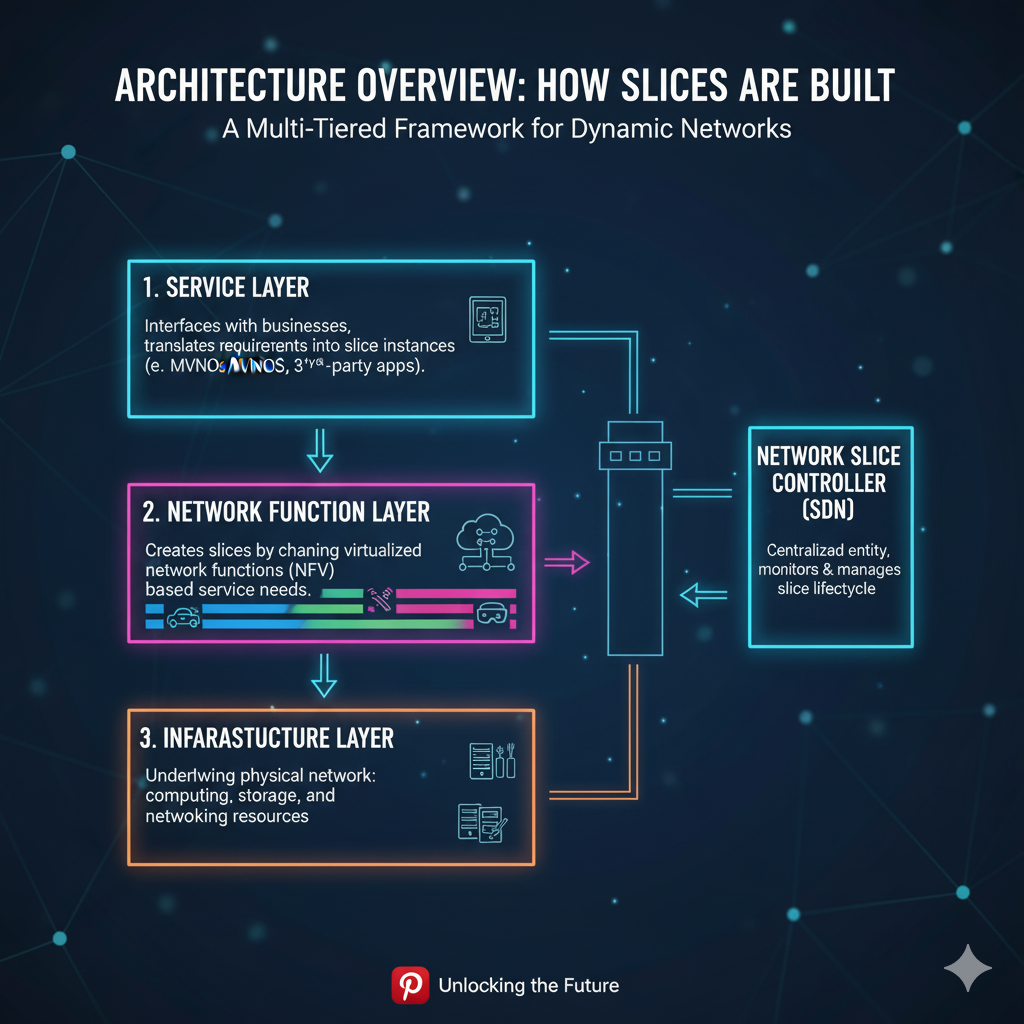
Complexity: The dynamic nature of creating, managing, and orchestrating multiple virtual networks on a single physical infrastructure introduces significant operational complexity.
Ensuring seamless operation and resource allocation requires sophisticated management systems [23].
Security and Isolation: Maintaining strict isolation between slices is paramount.
A breach in one slice must not compromise others.
This requires robust security mechanisms and careful design to prevent cross-slice attacks and ensure data privacy [24, 25].
Standardization and Interoperability: For network slicing to achieve its full potential, global standardization and interoperability across different vendors and operators are essential.
This ensures that slices can seamlessly extend across different network domains.
Monetization: Developing effective business models and pricing strategies for network slices is crucial for operators to realize the economic benefits of this technology [26].
Determining the value of different slice characteristics and ensuring fair resource allocation are complex tasks.
Resource Management: Efficiently allocating and managing resources across multiple dynamic slices is a continuous challenge.
Over-provisioning leads to waste, while under-provisioning can degrade service quality.
The Future is Sliced: Conclusion
5G network slicing is not just an incremental improvement; it’s a paradigm shift in network architecture.
By enabling operators to create bespoke virtual networks, each optimized for specific applications, it unlocks unprecedented levels of flexibility, efficiency, and innovation.
From revolutionizing industries with mission-critical IoT to enhancing everyday experiences with superior mobile broadband, network slicing is poised to be a cornerstone of the digital future.
While challenges related to complexity, security, and monetization remain, ongoing research and industry collaboration are steadily paving the way for its widespread adoption.
As we move forward, 5G network slicing will undoubtedly play a pivotal role in realizing the full potential of 5G, transforming how businesses operate, how services are delivered, and how we connect with the world around us.
References
[1] https://en.wikipedia.org/wiki/5G_network_slicing
[2] https://www.verizon.com/business/resources/articles/s/5g-network-slicing-do-you-have-the-team-you-need/
[3] https://www.geeksforgeeks.org/computer-networks/network-slicing-in-5g-networks/
[4] https://www.celona.io/5g-lan/network-slicing
[5] https://www.ericsson.com/en/network-slicing
[6] https://www.vonage.com/resources/articles/5g-network-slicing/
[7] https://www.blueplanet.com/resources/what-is-network-slicing.html
[8] https://www.techtarget.com/whatis/definition/network-slicing
[9] https://www.sharetechnote.com/html/5G/5G_NetworkSlicing.html
[10] https://info.support.huawei.com/info-finder/encyclopedia/en/Network+Slicing.html
[11] https://www.ericsson.com/en/blog/2023/10/network-slicing-for-5g-success
[12] https://www.netscout.com/blog/network-slicing
[13] https://pmc.ncbi.nlm.nih.gov/articles/PMC7256366/
[14] https://www.mdpi.com/1424-8220/25/13/3940
[15] https://www.abiresearch.com/blog/5g-network-slicing-challenges-and-opportunities
[16] https://www.p1sec.com/blog/security-challenges-of-network-slicing-in-5g
[17] https://stlpartners.com/articles/private-cellular/5g-network-slicing-examples/
[18] https://www.ericsson.com/en/network-slicing/network-slicing-use-cases-series
[19] https://elisapolystar.com/what-is-network-slicing/
[20] https://www.telefonica.com/en/communication-room/blog/5g-sa-network-slicing-specifications-cases/
[21] https://www.viavisolutions.com/en-us/5g-network-slicing
[22] https://cradlepoint.com/resources/blog/how-does-network-slicing-work/
[23] https://ieeexplore.ieee.org/document/8039298/
[24] https://www.mdpi.com/1424-8220/25/13/3940
[25] https://www.p1sec.com/blog/security-challenges-of-network-slicing-in-5g
[26] https:/www.abiresearch.com/blog/5g-network-slicing-challenges-and-opportunities
